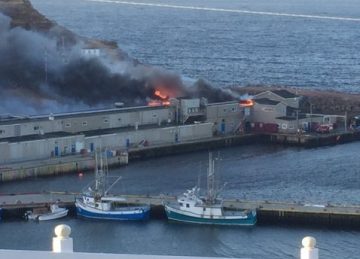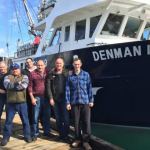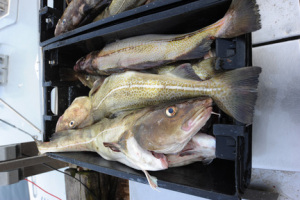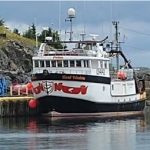Daily Archives: July 14, 2016
Commercial fisherman slams Noosa sustainability critic
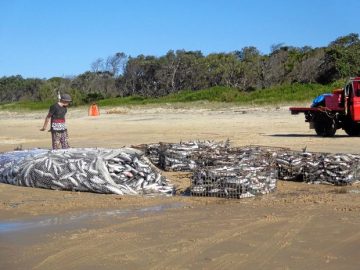 A commercial fisherman whose suppliers were net fishing at Noosa North Shore on the weekend has slammed claims the men were doing “irreparable damage” to local fish stocks. “How is it possible that netters (sic) from NSW can come here to the Noosa Biosphere/Noosa North Shore, camp where they like with no facilities in a no camp zone, take about 300 tonnes of breeding stock fish that should have spawned the lake systems here, truck them back to NSW…” he wrote. He called on the State Government to buy back commercial fishing licences and labelled the practice “unsustainable”. Richard Brown said, “For some reason Noosa is an area that they seem to isolate themselves and think that everyone’s coming and taking their product and leaving.” He said the idea that only Noosa residents should catch fish off Noosa beaches was a recurring one but had no scientific basis. “I wonder if those people in Noosa only eat Noosa tomatoes potato and steak,” he said. Mr Brown said Markwell Fisheries had been operating on the Noosa North Shore since 1944. The fact they are still there was proof their fishing practices were sustainable, he said. Read the rest here 20:57
A commercial fisherman whose suppliers were net fishing at Noosa North Shore on the weekend has slammed claims the men were doing “irreparable damage” to local fish stocks. “How is it possible that netters (sic) from NSW can come here to the Noosa Biosphere/Noosa North Shore, camp where they like with no facilities in a no camp zone, take about 300 tonnes of breeding stock fish that should have spawned the lake systems here, truck them back to NSW…” he wrote. He called on the State Government to buy back commercial fishing licences and labelled the practice “unsustainable”. Richard Brown said, “For some reason Noosa is an area that they seem to isolate themselves and think that everyone’s coming and taking their product and leaving.” He said the idea that only Noosa residents should catch fish off Noosa beaches was a recurring one but had no scientific basis. “I wonder if those people in Noosa only eat Noosa tomatoes potato and steak,” he said. Mr Brown said Markwell Fisheries had been operating on the Noosa North Shore since 1944. The fact they are still there was proof their fishing practices were sustainable, he said. Read the rest here 20:57
H.R. 4576, “Ensuring Access to Pacific Fisheries Act” Passes Committee Unanimously
 The House Natural Resources Committee has approved by voice vote, Congresswoman Aumua Amata Radewagen’s “Ensuring Access to Pacific Fisheries Act,” giving American Samoa a greater say in fishery management in the Western and Central Pacific. Radewagen says her bill, cosponsored with Insular subcommittee chair Don Young of Alaska, will do exactly what its title says. Radewagen’s bill, that had bipartisan committee support, would enable the US to take part in high seas fishery decisions made outside preexisting management agreements, such as the Magnuson-Stevens Act. The bill’s third title ensures access to traditional fishing grounds, but makes other changes, as well… Audio, Read the rest here Aumua’s Fishing Bill Passes Committee Unanimously Click here 18:12
The House Natural Resources Committee has approved by voice vote, Congresswoman Aumua Amata Radewagen’s “Ensuring Access to Pacific Fisheries Act,” giving American Samoa a greater say in fishery management in the Western and Central Pacific. Radewagen says her bill, cosponsored with Insular subcommittee chair Don Young of Alaska, will do exactly what its title says. Radewagen’s bill, that had bipartisan committee support, would enable the US to take part in high seas fishery decisions made outside preexisting management agreements, such as the Magnuson-Stevens Act. The bill’s third title ensures access to traditional fishing grounds, but makes other changes, as well… Audio, Read the rest here Aumua’s Fishing Bill Passes Committee Unanimously Click here 18:12
U.S. House Makes Strong Statement Against Marine Monument
 The U.S. House of Representatives made a strong statement against the declaration of marine monuments last night, passing an amendment offered by Congressman Lee Zeldin (R-New York) to bar funding for the designation of any National Marine Monuments by the President. The amendment to H.R. 5538, the Fiscal Year 2017 Interior and Environment Appropriations bill, passed the House by a vote of 225-202. Congressman Zeldin represents a coastal district and the fishing hub of eastern Long Island, N.Y. Yesterday, National Coalition for Fishing Communities (NCFC) members the Garden State Seafood Association (NJ), the Red Crab Harvesters Association (MA), the Long Island Commercial Fishing Association, and Blue Water Fisheries Inc. (NY) asked fellow NCFC members to reach out to their representatives to support the amendment. The Montauk Tilefish Association (NY) and the Monkfish Defense Fund joined them in calling for support for the amendment. Mr. Zeldin explained that he offered the amendment to keep commercial fishermen from losing access to important fishing areas through Marine Monument Designations. Opposition to the amendment was led by Congresswoman Niki Tsongas (D-Massachusetts) and Congresswoman Chellie Pingree (D-New Hampshire). Read the rest here 17:07
The U.S. House of Representatives made a strong statement against the declaration of marine monuments last night, passing an amendment offered by Congressman Lee Zeldin (R-New York) to bar funding for the designation of any National Marine Monuments by the President. The amendment to H.R. 5538, the Fiscal Year 2017 Interior and Environment Appropriations bill, passed the House by a vote of 225-202. Congressman Zeldin represents a coastal district and the fishing hub of eastern Long Island, N.Y. Yesterday, National Coalition for Fishing Communities (NCFC) members the Garden State Seafood Association (NJ), the Red Crab Harvesters Association (MA), the Long Island Commercial Fishing Association, and Blue Water Fisheries Inc. (NY) asked fellow NCFC members to reach out to their representatives to support the amendment. The Montauk Tilefish Association (NY) and the Monkfish Defense Fund joined them in calling for support for the amendment. Mr. Zeldin explained that he offered the amendment to keep commercial fishermen from losing access to important fishing areas through Marine Monument Designations. Opposition to the amendment was led by Congresswoman Niki Tsongas (D-Massachusetts) and Congresswoman Chellie Pingree (D-New Hampshire). Read the rest here 17:07
Bristol Bay reds late again; late run Kenai kings start strong
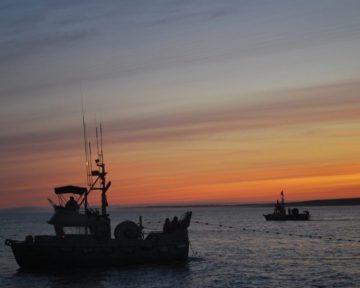 It’s the second late run in a row for the state’s most valuable salmon fishery, and the late run of king salmon in the state’s most popular river are showing up early in strong numbers. Bristol Bay, the world’s largest wild sockeye salmon producing region, experienced a massive late run of sockeye salmon last year, contributing with other market forces to drop the ex-vessel price of salmon to 50 cents per pound, or about half the historic average. This year, most signs point to a similarly late run. Late doesn’t necessarily mean below forecast. Last year, the historical midpoint of July 4 came and went with only 8.87 million fish harvested, about 35 percent less than the five-year average. All signs pointed to a Bristol Bay harvest of less than 20 million fish. By the end of the season, a late burst of sockeye produced one of the largest runs on record. Read the rest here 16:19
It’s the second late run in a row for the state’s most valuable salmon fishery, and the late run of king salmon in the state’s most popular river are showing up early in strong numbers. Bristol Bay, the world’s largest wild sockeye salmon producing region, experienced a massive late run of sockeye salmon last year, contributing with other market forces to drop the ex-vessel price of salmon to 50 cents per pound, or about half the historic average. This year, most signs point to a similarly late run. Late doesn’t necessarily mean below forecast. Last year, the historical midpoint of July 4 came and went with only 8.87 million fish harvested, about 35 percent less than the five-year average. All signs pointed to a Bristol Bay harvest of less than 20 million fish. By the end of the season, a late burst of sockeye produced one of the largest runs on record. Read the rest here 16:19
Do Lobsters Live Forever?
 Many animals that live in the deep, dark sea are subject to myths, and lobsters are no different. But one particular “belief” that lobsters would be immortal were it not for fishermen and hungry predators doesn’t exactly hold water, biologists told Live Science. “Lobsters age just like most other organisms,” said Thomas Matthews, a lobster biologist with the Florida Fish and Wildlife Conservation Commission. Some lobsters, however, do have extraordinarily long life spans. The American Lobster (Homarus americanus) can live to at least 100 years, which is more than five times the life span of the Caribbean spiny lobster (Panulirus argus) can live to at least 100 years, which is more than five times the life span of the Caribbean spiny lobster. Water temperature explains most of this difference in age, Matthews said. When lobsters are in warm water, such as the Caribbean, they have faster metabolisms. Conversely, when they’re in cold water, their metabolisms are slower. Read the rest here 14:42
Many animals that live in the deep, dark sea are subject to myths, and lobsters are no different. But one particular “belief” that lobsters would be immortal were it not for fishermen and hungry predators doesn’t exactly hold water, biologists told Live Science. “Lobsters age just like most other organisms,” said Thomas Matthews, a lobster biologist with the Florida Fish and Wildlife Conservation Commission. Some lobsters, however, do have extraordinarily long life spans. The American Lobster (Homarus americanus) can live to at least 100 years, which is more than five times the life span of the Caribbean spiny lobster (Panulirus argus) can live to at least 100 years, which is more than five times the life span of the Caribbean spiny lobster. Water temperature explains most of this difference in age, Matthews said. When lobsters are in warm water, such as the Caribbean, they have faster metabolisms. Conversely, when they’re in cold water, their metabolisms are slower. Read the rest here 14:42
Deal For New Fish Buyer With Kuskokwim Villages Could Fall Through
 The village of Quinhagak is hoping to sell fish to Seattle based company North West Sea Food Exchange after Costal Villages Region Fund stopped buying fish earlier this year. But the village is running into some unexpected problems that could prevent the partnership. When CVRF said they were no longer going to support their commercial fishing program, they meant it. “We need cranes to offload the boats,” Warren Jones said. Jones is the manager of the native corporation in Quinhagak. He says the village cannot process fish or even transport it without CVRF equipment right now. “We need forklifts to get the totes on the truck. We need the ice machine to keep the fish chilled,” Jones said. CVRF told Quinhagak in an email they would not be allowed to use equipment they had once used for the fisheries operation left in the village. Jones says he didn’t expect this, and now he’s worried the deal is dead. Read the rest here 13:44
The village of Quinhagak is hoping to sell fish to Seattle based company North West Sea Food Exchange after Costal Villages Region Fund stopped buying fish earlier this year. But the village is running into some unexpected problems that could prevent the partnership. When CVRF said they were no longer going to support their commercial fishing program, they meant it. “We need cranes to offload the boats,” Warren Jones said. Jones is the manager of the native corporation in Quinhagak. He says the village cannot process fish or even transport it without CVRF equipment right now. “We need forklifts to get the totes on the truck. We need the ice machine to keep the fish chilled,” Jones said. CVRF told Quinhagak in an email they would not be allowed to use equipment they had once used for the fisheries operation left in the village. Jones says he didn’t expect this, and now he’s worried the deal is dead. Read the rest here 13:44
Louisiana Wildlife and Fisheries Agents seize catch from illegal shrimper
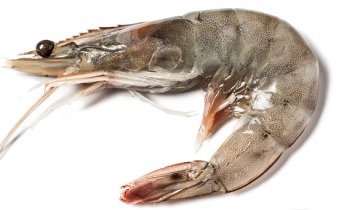 The inshore shrimp season closed across most of the Louisiana coast on July 3, but the Louisiana Department of Wildlife and Fisheries says that was just a formality to one Buras man. Department enforcement agents say they caught ., 32, using skimmers to catch shrimp Tuesday. The agents seized and sold 1,413 pounds of shrimp, the department said. Agents were in the area in response to complaints they had received of illegal shrimping taking place near Buras, the department reported in a news release Wednesday. Read the rest here 13:18
The inshore shrimp season closed across most of the Louisiana coast on July 3, but the Louisiana Department of Wildlife and Fisheries says that was just a formality to one Buras man. Department enforcement agents say they caught ., 32, using skimmers to catch shrimp Tuesday. The agents seized and sold 1,413 pounds of shrimp, the department said. Agents were in the area in response to complaints they had received of illegal shrimping taking place near Buras, the department reported in a news release Wednesday. Read the rest here 13:18
French fishermen bag a Portuguese submarine!
 French fishermen bagged the biggest catch of their lives when they reeled in a Portuguese submarine. The 220ft navy vessel got tangled in the net of a trawler off the English coast as it was taking part in a training mission. Portugal’s Armed Forces General Staff said the sub got too close to the boat when it was below the surface about 34 miles (55km) southeast of Lizard Point in Cornwall. The trawler, Daytona, which is registered to port in northwest France called Saint-Brieuc, was fishing in the area. Blissfully unaware there was an assault sub below them, fully equipped with eight torpedoes and four harpoons, the fishermen plodded along with their work. The Tridente-class submarine, which weighs more than 2,000 tonnes, got stuck in the net and hit the fishing boat as it tried to surface. Read the rest here 11:04
French fishermen bagged the biggest catch of their lives when they reeled in a Portuguese submarine. The 220ft navy vessel got tangled in the net of a trawler off the English coast as it was taking part in a training mission. Portugal’s Armed Forces General Staff said the sub got too close to the boat when it was below the surface about 34 miles (55km) southeast of Lizard Point in Cornwall. The trawler, Daytona, which is registered to port in northwest France called Saint-Brieuc, was fishing in the area. Blissfully unaware there was an assault sub below them, fully equipped with eight torpedoes and four harpoons, the fishermen plodded along with their work. The Tridente-class submarine, which weighs more than 2,000 tonnes, got stuck in the net and hit the fishing boat as it tried to surface. Read the rest here 11:04
Hawaii’s longline fleet about to hit its 3,554-ton bigeye tuna limit, enviro scorned rule will keep them fishing
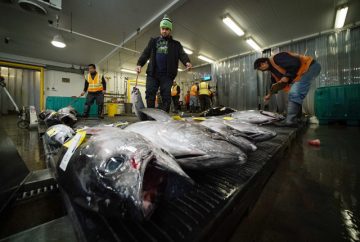 Hawaii’s longline fleet is about to hit its 3,554-ton limit for bigeye tuna in the Western and Central Pacific, prompting a closure date for the fishery of July 22, according to the National Oceanic and Atmospheric Administration. The longliners had caught an estimated 98 percent of their annual quota by Wednesday, National Marine Fisheries Service reported. The feds had been predicting longliners would hit their bigeye tuna limit by Aug. 14. But the closure will likely be short-lived thanks to a federal rule that proposes, like in years past, allowing U.S. Pacific Island territories — American Samoa, Guam and the Commonwealth of the Northern Mariana Islands — to each allocate up to 1,000 tons of their 2,000-ton quotas to U.S. longliners under a “specified fishing agreement.” David Henkin, staff attorney for Earthjustice, a nonprofit environmental law organization, calls it a “shell game” that allows overfishing, but the courts have so far disagreed. Read the rest here 10:23
Hawaii’s longline fleet is about to hit its 3,554-ton limit for bigeye tuna in the Western and Central Pacific, prompting a closure date for the fishery of July 22, according to the National Oceanic and Atmospheric Administration. The longliners had caught an estimated 98 percent of their annual quota by Wednesday, National Marine Fisheries Service reported. The feds had been predicting longliners would hit their bigeye tuna limit by Aug. 14. But the closure will likely be short-lived thanks to a federal rule that proposes, like in years past, allowing U.S. Pacific Island territories — American Samoa, Guam and the Commonwealth of the Northern Mariana Islands — to each allocate up to 1,000 tons of their 2,000-ton quotas to U.S. longliners under a “specified fishing agreement.” David Henkin, staff attorney for Earthjustice, a nonprofit environmental law organization, calls it a “shell game” that allows overfishing, but the courts have so far disagreed. Read the rest here 10:23
New Zealand Fisherman faces prosecution for deaths of albatrosses during observed fishing trip
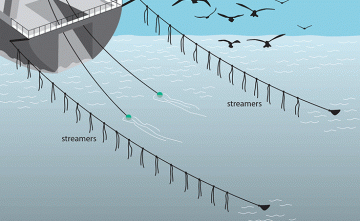 A commercial fisherman is to be prosecuted and faces a fine of up to $100,000 after dozens of albatross were killed during a fishing trip. The unnamed fisherman is being prosecuted by the Ministry For Primary Industries, which is now set to introduce additional measures to help prevent more seabird deaths as a result of the incident. A statement released by MPI today said the birds were killed when the commercial fisherman failed to use a tori line – a compulsory device used to scare birds away from baited hooks – while fishing for southern bluefin tuna off the West Coast of New Zealand. “The skipper faces a maximum fine of $100,000 in relation to an offence under the Fisheries (Commercial Fishing) Regulations and forfeiture of the vessel used in the operation.” The incident was reported by an MPI observer who was on board the vessel at the time. Read the rest here 09:47
A commercial fisherman is to be prosecuted and faces a fine of up to $100,000 after dozens of albatross were killed during a fishing trip. The unnamed fisherman is being prosecuted by the Ministry For Primary Industries, which is now set to introduce additional measures to help prevent more seabird deaths as a result of the incident. A statement released by MPI today said the birds were killed when the commercial fisherman failed to use a tori line – a compulsory device used to scare birds away from baited hooks – while fishing for southern bluefin tuna off the West Coast of New Zealand. “The skipper faces a maximum fine of $100,000 in relation to an offence under the Fisheries (Commercial Fishing) Regulations and forfeiture of the vessel used in the operation.” The incident was reported by an MPI observer who was on board the vessel at the time. Read the rest here 09:47
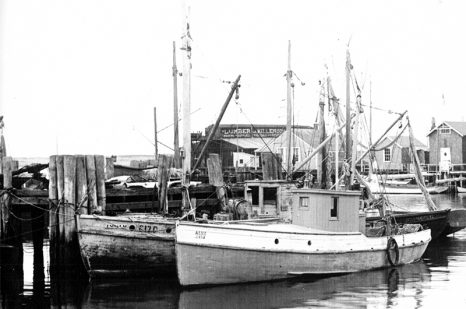
Nantucket History: Collapse of the Quahog Industry by Amy Jenness
In 1913 an Edgartown fisherman named Sam Jackson was dragging for flounder around Tuckernuck Shoal when he discovered a massive bed of quahogs and forever changed the island’s shellfish industry. For centuries local fishermen had harvested large clams, also known as quahogs, as well as oysters and scallops. Prior to Jackson’s discovery, quahog fishermen rowed their dories into Nantucket and Madaket harbors and gathered the shellfish in shallow water using large tongs. A typical catch was three to four bushels a day. For 1912, industry analysts guessed that the Nantucket quahog industry brought in about $100,000. In June of that year the Inquirer & Mirror noted, “Fifty-eight boats were at work on the quahog beds in the harbor Wednesday morning. And with this little gold mine right in the harbor, within a mile or so from town, the Nantucket fishermen have been foolish enough to permit thousands of bushels of seed quahogs to be shipped to other places to grow and become a source of revenue!” That year fishermen were upset that thousands of quahog seed had been shipped to other tows to fortify clam beds there. Read the story here 09:26
East Coast fishermen spar with federal government over cost of at-sea monitors
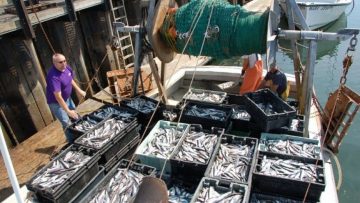 Every year, the federal government spends millions monitoring New England commercial fishermen to ensure they ply their timeless maritime trade in accordance with the law. Now, a judge is set to rule on who should foot the bill for the on-board monitors: the government or the fishing boat owners. The East Coast fishermen say sticking them with the bill would be the “death knell” for their industry and is illegal on the part of the federal government. Fishermen of important New England food species such as cod and haddock will have to start paying the cost of at-sea monitors soon under new rules. Monitors — third-party workers hired to observe fishermen’s compliance with federal regulations — collect data to help determine future fishing quotas and can cost about $18,000 a year, or $710 per voyage. “It is unlawful for NOAA to force struggling fishermen to pay for their own at-sea monitors,” said former federal judge Alfred Lechner, the institute’s president and CEO. “The significant costs of these regulations should be the responsibility of the government.” Read the rest here 08:57
Every year, the federal government spends millions monitoring New England commercial fishermen to ensure they ply their timeless maritime trade in accordance with the law. Now, a judge is set to rule on who should foot the bill for the on-board monitors: the government or the fishing boat owners. The East Coast fishermen say sticking them with the bill would be the “death knell” for their industry and is illegal on the part of the federal government. Fishermen of important New England food species such as cod and haddock will have to start paying the cost of at-sea monitors soon under new rules. Monitors — third-party workers hired to observe fishermen’s compliance with federal regulations — collect data to help determine future fishing quotas and can cost about $18,000 a year, or $710 per voyage. “It is unlawful for NOAA to force struggling fishermen to pay for their own at-sea monitors,” said former federal judge Alfred Lechner, the institute’s president and CEO. “The significant costs of these regulations should be the responsibility of the government.” Read the rest here 08:57
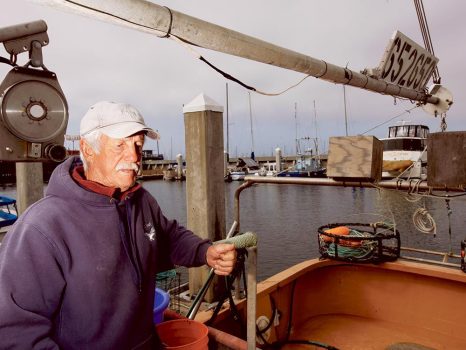
California fishermen, enviros fight over proposal to protect underwater seamounts.
California fishermen first learned of the proposal in May, out of the blue. In a six-page, unattributed document, the proposal suggested turning several of the state’s offshore seamounts, ridges and banks into national monuments, permanently closing them to fishing as well as oil and gas development. Under the federal Antiquities Act of 1906, presidents have the power to designate monuments, and implicitly, the proposal asked President Barack Obama to exercise that executive power. “It’s fishing management by fiat,” says Diane Pleschner-Steele, director of the California Wetfish Producers Association. Among the partners behind the proposals is Marine Conservation Institute, and MCI President Lance Morgan, a marine biologist, disagrees that he’s trying to avoid due process, and says that’s just how these things get done. Read the rest here 08:08






